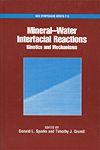 | ||||
| ||||
| NOTE: This material may be protected by copyright law (Title 17, U.S. Code). | |||
Sparks, D.L., and T.J. Grundl. Editors. 1999. Mineral-Water Interfacial Reactions: Kinetics and Mechanisms. ACS Symp. Ser. 715, Am. Chem. Soc. Washington, DC. Edited by DONALD L. SPARKS, University of Delaware, and TIMOTHY J. GRUNDL, University of Wisconsin, Milwaukee ACS Symposium Series 715, 1999. This collection clearly explains how to decipher and predict contaminant fate in the environment. It shows how to combine kinetic methods and molecular-scale spectroscopic and microscopic techniques to analyze mineral/water interfacial reactions in situ and obtain practical information on the mobility, speciation, and bioavailability of contaminants. 448 pp.; 3 halftones, 143 figures; 6 x 9; 0-8412-3593-7 Preface Processes that occur at mineral-water interfaces, such as sorption, precipitation, dissolution, and electron transfer are central to the full understanding of the geochemistry of natural systems. Geochemical processes at the mineral-water interface also markedly affect the fate, mobility, speciation, and bioavailability of inorganic and organic contaminants in the environment. In the past, researchers focused mostly on equilibrium aspects of mineral-water interfacial reactions. However, it is increasingly clear that a knowledge of the kinetics and mechanisms of interfacial reactions is critical for a full understanding of natural systems and the prediction of contaminant fate in the environment. Recently, significant advances have been realized in the employment of kinetic methods and molecular-scale spectroscopic and microscopic techniques to study mineral-water interfacial reactions in-situ. In the past decade, researchers have coupled the detailed understanding of surface structure derived from molecular-scale studies with experimental and modeling studies of macroscopic surface behavior. This synergism has resulted in a dramatic increase in the ability to decipher and predict both the kinetics and mechanisms of mineral-water interfacial reactions. It is these important aspects that form the central theme of this book. The chapters in the book are based on invited papers presented at a major American Chemical Society (ACS), Division of Geochemistry Symposium, “Kinetics and Mechanisms of Reactions at the Mineral-Water Interface”, held April 13-17, 1997, in San Francisco, California. We clearly recognized that the symposium topic was inherently multidisciplinary. Accordingly, the invited authors of the chapters, who are internationally recognized in their fields, encompass a wide spectrum of areas including environmental chemists, engineers, soil chemists, microbiologists, geochemists, hydrogeologists, limnologists, oceanographers, and spectroscopists-microscopists. The last major compilation dealing primarily with interfacial processes in the environment was based on an ACS Symposium held six years ago. Reflective of the progress made in the intervening time, this volume contains research advances that cut across a much broader spectrum of phenomena. The first section of the book deals specifically with spectroscopic-microscopic techniques that can be used in combination with macroscopic approaches to glean mechanistic information on mineral-water reactions and processes. The second section emphasizes computer models that are used to elucidate surface mediated reaction mechanisms. The remainder of the volume is organized around reaction type. Sections are included on sorption-desorption of inorganic species, sorption-desorption of organic species, precipitation-dissolution processes, heterogeneous electron transfer reactions, photochemically driven reactions, and microbially mediated reactions. The book should be of interest to professionals and students in chemistry, soil science, geochemistry, microbiology, environmental engineering, and marine studies. | ||||
 | ||||||
Home | Members | News | Links | Research | CCZR | Awards | Alumni | Publications | Search | |
| |


